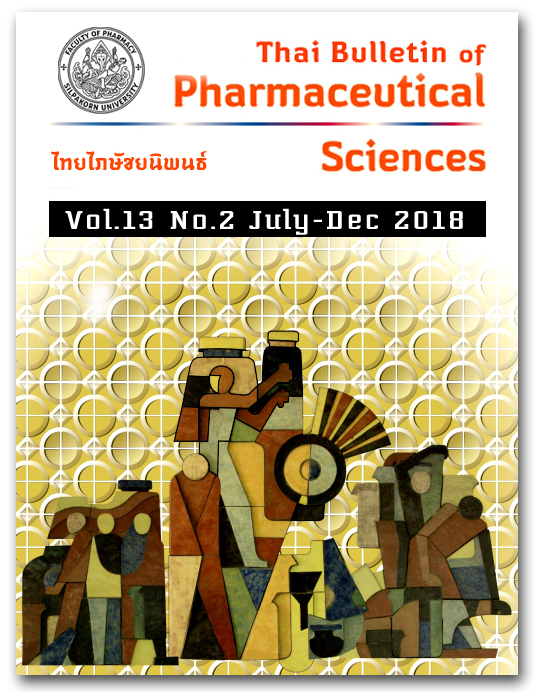BEHAVIORS AND ATTITUDES OF MEDICATION LABEL WRITINGACCORDING TO THE GOOD PHARMACY PRACTICE OF NORTHERN COMMUNITY PHARMACISTS
DOI:
https://doi.org/10.69598/tbps.13.2.117-127Keywords:
behaviors, community pharmacists, medicine labelling, good pharmacy practiceAbstract
ABSTRACT
This research aimed to survey the completeness of information on medicine pouches, medication labelling behaviors and attitudes of community pharmacists in the northern of Thailand toward the information of drug labelling following the good pharmacy practice (GPP). The data were collected using a questionnaire sent by mail. The subjects were 279 community pharmacies (type I) located in 8 provinces of northern Thailand. Forty-nine questionnaires (17.6%) were analyzed. The study found that no drugstore showed complete information on the medicine pouches according to GPP. The most displayed information covered drug use directions (49, 100%); drug indications (46, 93.9%) and drug precautions (44, 89.9%). No respondent could write a complete medicine label. The information mostly written on drug label included drug use directions (37, 75.5%); drug indications (33, 67.3%) and the name, address and telephone number of the drug store (29, 59.2%). On the other hand, the respondents have not written the following information on the labels: pharmacist signature (38, 77.6%); patient’s name (30, 61.2%) and date of drug dispensing (23, 46.9%). A study of attitude of community pharmacists toward medicine labels found that the most important information consisted of drug use directions (4.92 ± 0.27), drug indications (4.80 ± 0.46) and drug precautions (4.57 ± 0.68). The respondents indicated that the less important information on drug pouches included pharmacists' signature (2.55 ± 1.14); the patients' name (2.82 ± 1.19), and the amount of drug dispensed (3.02 ± 1.18). It can be concluded that almost every drug stores failed to display complete important information, and the community pharmacists did not entirely label the medicine pouches according to GPP. The attitudes of community pharmacists towards the information on drug labels had low level in some areas.
References
2. Bureau of Drug Control, Food and Drug Administration. Ministry of Public Health. Statistics of nationwide licensed drug stores 1996-2013. [Online]. 2013. [cited 2016 Jun 23]; Available from: https://www.fda.moph.go.th/sites/Drug/ SitePages/Queries.aspx (in Thai)
3. Tangploy S. Drug buying behavior for the drug stores among consumers in Phrapradaeng district, Samutprakran [master’s thesis]. Bangkok: Srinakharinwirot University; 2010. 224p. (in Thai)
4. Mathuros P. The study of consumer behavior and attitude toward drugstore in Mueang district, Phang Nga province. FDA J. 2014;32-40. (in Thai)
5. Parinyarux P, Suwannaprom P. Attitudes and stage of change towards participation to the community pharmacy development and accreditation project of pharmacists drug store owners in Muang district, Chiang Mai province. Thai Pharm Health Sci J. 2014:9(4):164-9. (in Thai)
6. Settasoontari P. Factors affecting the drugstores’ tendency to join the pharmacy advancement project for quality drugstores.Dep Health Serv Support J. 2013:9(1); 44-56. (in Thai)
7. Thavornwattanayong W, Yuklanthuan C, Panyakrua P, Nakarin R, Athitrakoonlert E. Pharmacy owner’s opinions in Nakorn Pathom province on the notification of the ministry of public health B.E. 2557 (2014) on the regulations of setting, equipment and pharmacy practice. Thai Bull Pharm Sci. 2016;11(2):27-44. (in Thai)
8. Wimonkittipong S, Panthong M. Guideline to achieve mandatory GPP regulation. Nonthaburi: Bureau of Drug Control,Ministry of Public Health, 2015. (in Thai)
9. Wimonkittipong S. The ability of drug stores to develop for attain the (draft) notification of the ministry of public health on good pharmacy practice. Nonthaburi: Bureau of Drug Control,Ministry of Public Health, 2015. (in Thai)
10. Plianbangchang P, Hongsamut D. Drugstore owners’ opinions on drugstore standards of the Pharmacy Council: a nation-wide survey. J Health Sci. 2006;15(1):111-22. (in Thai)
11. Boonchoong N, Chanakij T, Dorkrakklang P, Wongsa P, Sootsol S, Yospanya S. Compliance with the community pharmacy project after accreditation by the pharmacy council. KKU Res J. 2007;12(1):53-65. (in Thai)
12. Kaew-on P, Lerkiatbundit S, Saengcharoen W. Is there any difference in the quality between the pharmacies accredited by the pharmacy council and non-accredited pharmacies? Thai J Pharm Pract. 2012;4(2):39-64. (in Thai)
13. Nontaleeruk P, Intharapong S, Plianbangchang P. Community pharmacists’ medicine labeling behavior in Bangkok and its metropolitian areas. Naresuan Univ J. 2006;14(3):27-34. (in Thai)
14. Bernard HR. Social research methods: qualitative and quantitative approaches. California: Sage Publications; 2000.
15. The Pharmacy Council of Thailand. The skill manual of professional competencies of pharmacy profession. Nonthaburi: The Pharmacy Council of Thailand, 2011. (in Thai)
16. Ross JA. The reliability, validity, and utility of self-assessment. PARE. 2006;10(11):1-8.
17. Eva KW, Regehr G. Self-assessment in the health professions: a reformulation and research agenda. Acad Med. 2005;80(10 Suppl):S46-54.
18. Stojkov S, Tadic I, Crnjanski T, Krajnovic D. Assessment and self-assessment of the pharmacist’s competencies using the Global Competency Framework (GbCF) in Serbia. VojnosanitPreg. 2016;73(9)803-20.
19. Saengcharoen W, Chongsuvivatwong V, Lerkiatbundit S and Wongpoowarak P. Client and pharmacist factors affecting practice in the management of upper respiratory tract infection presented in community pharmacies: a simulated client study. Int J Pharm Pract. 2008;16:265-70.
20. Saengcharoen W, Lerkiatbundit S. Migraine management in community pharmacies: practice patterns and knowledge of pharmacy personnel in Thailand. Headache. 2013;53(9):1451-63.
Downloads
Published
How to Cite
Issue
Section
License
All articles published and information contained in this journal such as text, graphics, logos and images is copyrighted by and proprietary to the Thai Bulletin of Pharmaceutical Sciences, and may not be reproduced in whole or in part by persons, organizations, or corporations other than the Thai Bulletin of Pharmaceutical Sciences and the authors without prior written permission.



